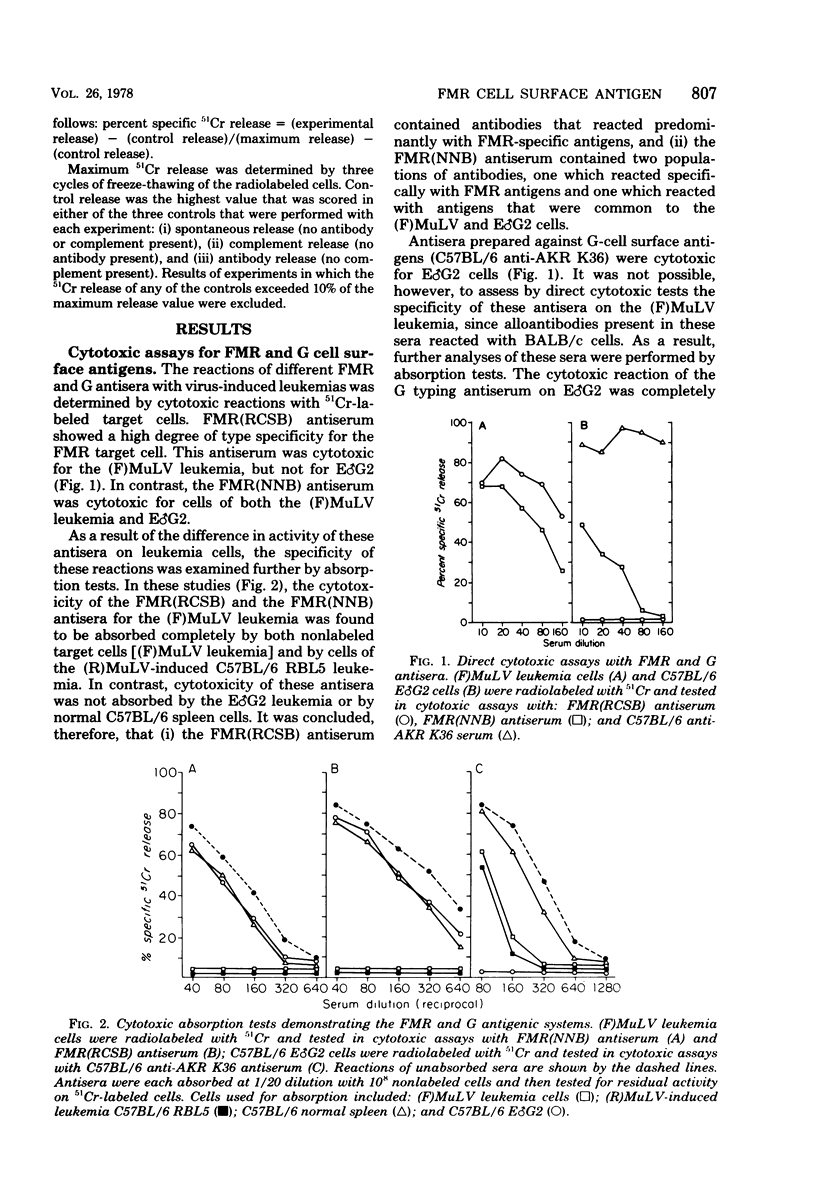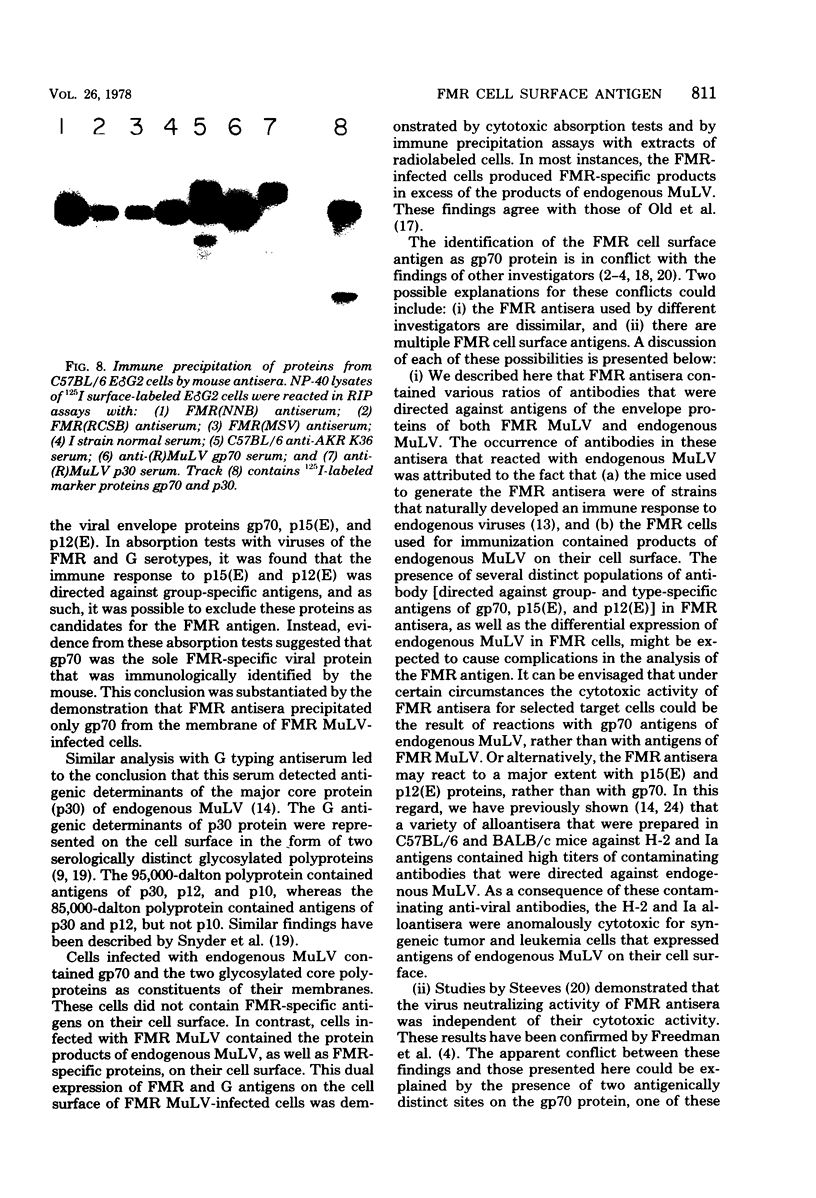Abstract
FMR antigens are found on the surface of cells infected with Friend, Moloney, and Rauscher murine leukemia viruses (MuLV). These antigens are serologically distinct from the G cell surface antigens that are found on cells infected with endogenous MuLV (AKR and Gross virus). Cell surface antigens of both virus groups are immunogenic in mice, and immunization with appropriate virus-infected cells leads to the production of cytotoxic antisera. The cytotoxic activity of FMR antisera can be absorbed by disrupted preparations of Rauscher MuLV, but not by AKR MuLV. FMR antisera precipitate the viral envelope proteins gp70, pl5(E), and p12(E) from detergent-disrupted preparations of [3H]leucine-labeled MuLV. The reaction of these antisera with p15(E) and p12(E) proteins is directed against group-specific antigens and can be absorbed with AKR MuLV; in contrast, the reaction of these antisera with gp70 is directed against type-specific antigens and is absorbed only by viruses of the FMR group. In immune precipitation assays with detergent-disrupted 125I surface-labeled cells, FMR antisera react only with type-specific antigens of the viral envelpe protein. On the basis of these findings we conclude that the FMR cell surface antigen is a determinant on the MuLV env gene product.
Full text
PDF







Images in this article
Selected References
These references are in PubMed. This may not be the complete list of references from this article.
- Eckner R. J., Steeves R. A. A classification of the murine leukemia viruses. Neutralization of pseudotypes of Friend spleen focus-forming virus by type-specific murine antisera. J Exp Med. 1972 Oct 1;136(4):832–850. doi: 10.1084/jem.136.4.832. [DOI] [PMC free article] [PubMed] [Google Scholar]
- Fenyö E. M., Grundner G., Klein E. Virus-associated surface antigens on L cells and Moloney lymphoma cells. J Natl Cancer Inst. 1974 Mar;52(3):743–751. doi: 10.1093/jnci/52.3.743. [DOI] [PubMed] [Google Scholar]
- Freedman H. A., Lilly F., Steeves R. A. Antigenic properties of cultured tumor cell lines derived from spleens of Friend virus-infected BALB/c and BALB/c-H-2b mice. J Exp Med. 1975 Dec 1;142(6):1365–1376. doi: 10.1084/jem.142.6.1365. [DOI] [PMC free article] [PubMed] [Google Scholar]
- Friedman M., Lilly F., Nathenson S. G. Cell surface antigen induced by Friend murine leukemia virus is also in the virion. J Virol. 1974 Nov;14(5):1126–1131. doi: 10.1128/jvi.14.5.1126-1131.1974. [DOI] [PMC free article] [PubMed] [Google Scholar]
- Kessler S. W. Rapid isolation of antigens from cells with a staphylococcal protein A-antibody adsorbent: parameters of the interaction of antibody-antigen complexes with protein A. J Immunol. 1975 Dec;115(6):1617–1624. [PubMed] [Google Scholar]
- Laemmli U. K. Cleavage of structural proteins during the assembly of the head of bacteriophage T4. Nature. 1970 Aug 15;227(5259):680–685. doi: 10.1038/227680a0. [DOI] [PubMed] [Google Scholar]
- Ledbetter J., Nowinski R. C., Emery S. Viral proteins expressed on the surface of murine leukemia cells. J Virol. 1977 Apr;22(1):65–73. doi: 10.1128/jvi.22.1.65-73.1977. [DOI] [PMC free article] [PubMed] [Google Scholar]
- Ledbetter J., Nowinski R. C. Identification of the Gross cell surface antigen associated with murine leukemia virus-infected cells. J Virol. 1977 Aug;23(2):315–322. doi: 10.1128/jvi.23.2.315-322.1977. [DOI] [PMC free article] [PubMed] [Google Scholar]
- Micheel B., Bierwolf D. Demonstration of Graffi virus-induced surface antigens of leukemia cells by indirect immunoferritin technique. Exp Cell Res. 1969 Feb;54(2):268–271. doi: 10.1016/0014-4827(69)90249-3. [DOI] [PubMed] [Google Scholar]
- Nowinski R. C., Kaehler S. L., Burgess R. R. Immune response in the mouse to endogenous leukemia viruses. Cold Spring Harb Symp Quant Biol. 1975;39(Pt 2):1123–1128. doi: 10.1101/sqb.1974.039.01.128. [DOI] [PubMed] [Google Scholar]
- Nowinski R. C., Klein P. A. Anomalous reactions of mouse alloantisera with cultured tumor cells. II. Cytotoxicity is caused by antibodies to leukemia viruses. J Immunol. 1975 Nov;115(5):1261–1268. [PubMed] [Google Scholar]
- Nowinski R. C., Watson A. Immune response of the mouse to the major core protein (p30) of ecotropic leukemia viruses. J Immunol. 1976 Aug;117(2):693–696. [PubMed] [Google Scholar]
- OLD L. J., BOYSE E. A., STOCKERT E. TYPING OF MOUSE LEUKAEMIAS BY SEROLOGICAL METHODS. Nature. 1964 Feb 22;201:777–779. doi: 10.1038/201777a0. [DOI] [PubMed] [Google Scholar]
- Old L. J., Boyse E. A., Stockert E. The G (Gross) leukemia antigen. Cancer Res. 1965 Jul;25(6):813–819. [PubMed] [Google Scholar]
- Siegert W., Fenyö E. M., Klein G. Separation of the Moloney leukemia virus-determined cell surface antigen (MCSA) from known virion proteins associated with the cell membrane. Int J Cancer. 1977 Jul 15;20(1):75–82. doi: 10.1002/ijc.2910200113. [DOI] [PubMed] [Google Scholar]
- Snyder H. W., Jr, Stockert E., Fleissner E. Characterization of molecular species carrying gross cell surface antigen. J Virol. 1977 Aug;23(2):302–314. doi: 10.1128/jvi.23.2.302-314.1977. [DOI] [PMC free article] [PubMed] [Google Scholar]
- Steeves R. A. Cellular antigen of Friend virus-induced leukemias. Cancer Res. 1968 Feb;28(2):338–342. [PubMed] [Google Scholar]
- Strand M., August J. T. Structural proteins of RNA tumor viruses as probes for viral gene expression. Cold Spring Harb Symp Quant Biol. 1975;39(Pt 2):1109–1116. doi: 10.1101/sqb.1974.039.01.126. [DOI] [PubMed] [Google Scholar]
- Tung J. S., Yoshiki T., Fleissner E. A core polyprotein of murine leukemia virus on the surface of mouse leukemia cells. Cell. 1976 Dec;9(4 Pt 1):573–578. doi: 10.1016/0092-8674(76)90039-8. [DOI] [PubMed] [Google Scholar]
- Vitetta E. S., Baur S., Uhr J. W. Cell surface immunoglobulin. II. Isolation and characterization of immunoglobulin from mouse splenic lymphocytes. J Exp Med. 1971 Jul 1;134(1):242–264. doi: 10.1084/jem.134.1.242. [DOI] [PMC free article] [PubMed] [Google Scholar]







